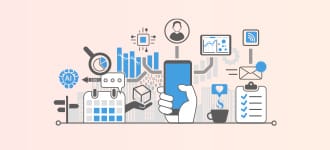Key takeaways:
- Business intelligence (BI) is an umbrella term that refers to a set of technologies and techniques used to extract data from various sources, analyse it, and present it to managers.
- BI can help you make better decisions by providing information about your business that’s relevant and accurate.
- BI can help you understand how different aspects of your business impact each other, so you can focus on what matters most and avoid distractions.
Business Intelligence (BI) is a branch of information technology that uses data to help organisations make better business decisions. It can be used in various ways to improve your company’s performance.
Business intelligence tools can help you identify problems, evaluate the effectiveness of your strategies, and predict future trends. They’re beneficial when figuring out how to invest in new products or services or grow your business.
BI comprises three components: data, analytics, and visualisation.
Data is information that has been collected and stored in an organised manner. Data can be structured or unstructured. While structured data includes numerical values, text, and dates, unstructured data includes images, audio recordings, videos, and emails.
Business intelligence and analytics use algorithms to analyse structured data and make predictions based on it. Predictive analytics uses historical information to predict future outcomes based on trends. Prescriptive analytics considers current and historical data to make recommendations for future actions.
Visualisation allows users to explore large amounts of data quickly and easily through interactive visualisations such as charts and dashboards.
Business intelligence is becoming increasingly popular, not just because it helps companies make more money! Besides, the market for business intelligence tools is growing at an annual rate of 8%, making it one of the fastest-growing technologies today.
What is business intelligence?
Business intelligence (BI) is a method of using data to make better business decisions. BI helps companies make more informed decisions based on the information they have. Business intelligence tools can also help companies predict trends and patterns in their data, allowing them to see what’s coming next—and how best to prepare for it.
Business intelligence tools allow users to analyse and visualise data to identify areas for improvement and growth opportunities. By using business intelligence tools, companies can get a more accurate picture of their performance against competitors and market conditions, which allows them to allocate resources more effectively and plan future projects more accurately.
BI aims to turn raw data – information about sales, inventory levels, prices, and other metrics – into something useful for decision-making purposes. It also aims to do so in real-time so that a company can act on information as soon as it becomes available.
History of business intelligence
The history of business intelligence (BI) has been a long and winding road, but it’s been an important one. BI began as a way for businesses to make sense of the data they were gathering and analysing. Still, it has become an integral part of every business’s approach to information.
Businesses have always collected data, but it wasn’t until the late 20th century that they started collecting it in large enough quantities to analyse it. The first big step toward BI was when companies started using computers to store and process data. This allowed them to analyse the data more accurately than before, making it possible for them to create more accurate models for predicting future trends.
The next big step toward BI came when companies started using a software programme called “data warehouses”. These warehouses allowed companies to store vast amounts of data without losing fidelity or accuracy in its representation on their computer systems. It also made it easier for all employees within a company—not just those who had access to the warehouse—to access their data whenever they needed it or wanted answers about what was happening within their organisation at any given time (or even if something had happened in the past).
As more people started using business intelligence software, it became clear that there were some limitations on what BI could do—one of these was its inability to predict future trends based on historical data alone. To accurately predict future events, analysts had to be able to incorporate other types of information into their models—this led researchers at top institutions to develop machine learning algorithms that could analyse data alongside human intuition (called “expert systems”).
Data Analytics vs. Business Analytics vs. Business Intelligence
Understanding the difference between business intelligence and business analytics and data analytics is essential.
| Data Analytics | Business Analytics | Business Intelligence |
|---|---|---|
| Its goal is to provide an understanding of customer needs and behaviours allowing businesses to make informed decisions about marketing strategies and product development. | The goal of business analytics is to gain insight into your customers’ behaviours, allowing businesses to accordingly strategise products, services, and marketing campaigns. | Its goal is to provide an overview of relevant information and data in a way that makes it easy for business to understand its users. |
| Follows a data driven approach. | Implies statistical analysis of data. | Provides service based on internal data. |
| Reveals insights from data letting businesses take the right next steps. | Emphasises structured data. | Uses IT to access, collect, cleanse, integrate and analyse data in order to present it in a format that’s easy to understand. |
| Tableau and Qlikview are some of the tools used in data analytics and visualisation. | Business analytics tools include data visualisation software, data management platforms, among analytics tools and data mining tools. | Its tools include dashboards, data visualisations, KPIs, etc. |
- Business Intelligence vs Data Analytics
Business intelligence combines data analytics, reporting, and business management. It makes it possible for businesses to make better decisions by helping them understand information already available in their organisation.
Business intelligence and analytics aren’t always the same thing either! BI refers to collecting information from different sources, transforming and organising it into a usable format, and then presenting it in a way that allows decision makers to make better-informed decisions.
- Data Visualisation vs Reporting
Data visualisation helps you visualise data in a way that allows you to see patterns or trends more clearly than a table of numbers would let you do. Reporting provides information about what has happened in the past but does not help predict what will happen next or help us make better decisions about our future actions.
- Predictive Analytics vs Descriptive Analytics
Predictive analytics uses algorithms to predict future outcomes based on historical data; descriptive analytics helps you understand past events to make better predictions about what will happen next time.
- Data Analytics vs Business Analytics
Data analytics is analysing and interpreting data to find patterns or trends. In contrast, business analytics is the application of statistical and mathematical methods to derive meaningful information from data and then use that information for business purposes.
Business analytics also focuses on gathering information from multiple sources and presenting it. Still, it typically doesn’t include transforming or organising that information in any way—it just explains it raw as-is.
YOU MAY ALSO LIKE: Business Intelligence vs Business Analytics: Simplified
How does business intelligence work?
The best way to understand how business intelligence works is to see it in action. Let’s look at how BI can help you make better decisions about your company’s future.
Business intelligence uses data gathered from many different sources, such as financial reports and customer surveys, to provide managers with a comprehensive view of the company’s performance over time. This information can then be used to identify trends and patterns within the data so that management can make informed decisions based on facts rather than assumptions or hunches alone.
For example: if your company has been losing customers lately due to poor customer service levels, this might be because they’re not satisfied with their overall experience when buying products or services from your storefront locations around town (or online). In this case, business intelligence tools would provide management with statistical evidence showing how many people have complained about specific problems during each transaction over time so that they can track down where these issues may be happening more frequently than others.
Business intelligence is usually a data-driven process. Once you’ve gathered information from different sources, you can use algorithms and statistical models to discover insights into how things work—or don’t work!
For example, looking at your sales data, you might find that customers who buy from your website spend more than those who purchase in person. This could lead you to try out different advertising or develop new products that appeal more directly to online shoppers.
Business Intelligence processes
Business intelligence (BI) processes are the steps that take data from raw, unstructured sources and make it useful for decision-making.
These processes include –
- Data integration
The data integration process is the first step in a BI project. This process involves getting the data from various sources, cleaning it, organising it, and storing it in a way that makes sense for analysis.
- Data analysis
Here, you use statistical methods and maths to analyse your data and generate insights about how it can be used in your business.
- Storing data
Putting the transformed, processed data into long-term storage so that it can be referred to later if necessary
- Reporting
Reporting is the final step in a BI project, where you take the insights generated by your analysis and turn them into reports that can be used by others in the organisation so they can make better decisions based on those insights.
Significance of Business Intelligence
Business intelligence has become an essential part of the business world. The wide range of business intelligence benefits and challenges brought to any company makes it a must-have for all businesses.
Business intelligence tools provide insights into critical areas such as –
- Sales and revenue
By understanding who their customers are and where they’re spending money online (or not), companies can create targeted content that resonates with those specific groups of people—and ultimately drive sales growth with less effort than traditional advertising methods like TV commercials or billboards would require.
- Customer retention
Customers who feel valued will continue to use your products or services. At the same time, those who are dissatisfied with their experience may look elsewhere. Business intelligence can help you identify why customers are leaving your company so that you can address the issue before they decide to take their business elsewhere.
- Supplier relationships
Suppliers provide vital resources at a reasonable price, which helps keep costs down for manufacturers and retailers alike. However, suppose one supplier fails to deliver on time or at all. In that case, business operations can come grinding to a halt. Business intelligence lets companies know precisely what kind of resources they will need from their suppliers so that everything runs smoothly from start to finish without any hassles.
ALSO READ: Importance of Business Intelligence in B2C companies
Types of BI analysis
The BI industry has a lot of jargon, and it can be hard to figure out the different types of BI analysis. We’ve broken down the most common types of BI analysis into four categories: descriptive, diagnostic, predictive, and prescriptive.
| Descriptive analysis | This type of analysis is used to describe past events and data. It includes simple statistics, such as averages and frequencies. |
| Diagnostic analysis | The diagnostic analysis is used to predict future events based on past data and trends. It includes predictive analytics, forecasting, and statistical modelling. |
| Predictive analysis | Predictive analysis allows you to predict future events based on current data and historical trends. It includes regression analyses, cluster analyses, and other statistical methods where you can predict future outcomes based on the variables in your dataset. |
| Prescriptive analysis | This type of analysis provides recommendations for improving operations based on historical data. It can take into account future trends for planning purposes. |
Examples of Business Intelligence in significant sectors
Here are some examples of Business Intelligence in major sectors –
- Online Retail: This sector relies on customer data to optimise the customer experience, which ultimately increases sales and market share.
- Healthcare: This sector uses business intelligence to make better decisions about patient care, reduce costs, and improve the efficiency of operations.
- Manufacturing: Business intelligence helps manufacturers improve their supply chain management so they don’t run out of parts or materials needed for production. It also helps them get products shipped quicker and more efficiently, which saves money.
- Financial Services: Financial institutions use BI to monitor their customers’ accounts, understand their spending habits, gauge market sentiment about their products or services, and generally stay competitive by staying one step ahead of the competition at all times (or at least trying).
Business intelligence tools
Business intelligence tools are a great way to get a snapshot of your company’s performance and ensure you’re on the right path. There are plenty of business intelligence tools out there, but we’ve narrowed it down to the three best:
- Google Analytics
Google Analytics gives you a complete view of your website’s traffic, including traffic sources, user behaviour, and more. You can also use it to create custom reports and run A/B tests to figure out what works best for your business.
- SAP Business Objects
SAP Business objects is a great business intelligence tool because it helps you get the information you need to make smart decisions. It’s fast. The dashboard building process only takes a few minutes, so you can quickly get what you need without having to wait around for too long. It’s flexible. SAP Business Objects allows you to work with any kind of data source, which means it will work with your existing systems so that all your data is available in one place instead of scattered across multiple locations where it might not be easy for everyone on your team to access at once!
- Datapine
It has a lot of features. You can create custom visualisations, add interactive charts and graphs, utilise predictive analytics tools to make predictions about future outcomes based on current trends in your data, and much more.
Future of Business Intelligence
The future of business intelligence is changing the way we think about data. Today, BI is often seen as an add-on to existing systems and processes. But it will become a fundamental part of how we do business in the future.
BI will continue to change how businesses are run in the future by assisting companies in making important decisions that affect their bottom line. In addition to providing insights on how well a company is performing, business intelligence tools should also help companies decide what direction they want their business to go in the future.
Summing it up
Business intelligence is a way for companies to collect data from various sources and make it useful. There are many different ways to do this. Still, the most effective way involves using software that allows you to visualise your data in an easy-to-understand manner so that your employees can use it daily to make better decisions.
Fuel your career in Business Intelligence by enrolling for the world-class courses offered by Manipal Academy of Higher Education (MAHE) at Online Manipal. You can enrol in either online M.Sc in Business Analytics or if you’re an experienced professional, you can enrol in an MBA with Business Analytics specialisation. Join today!
Become future-ready with our online M.Sc. in Business Analytics program









